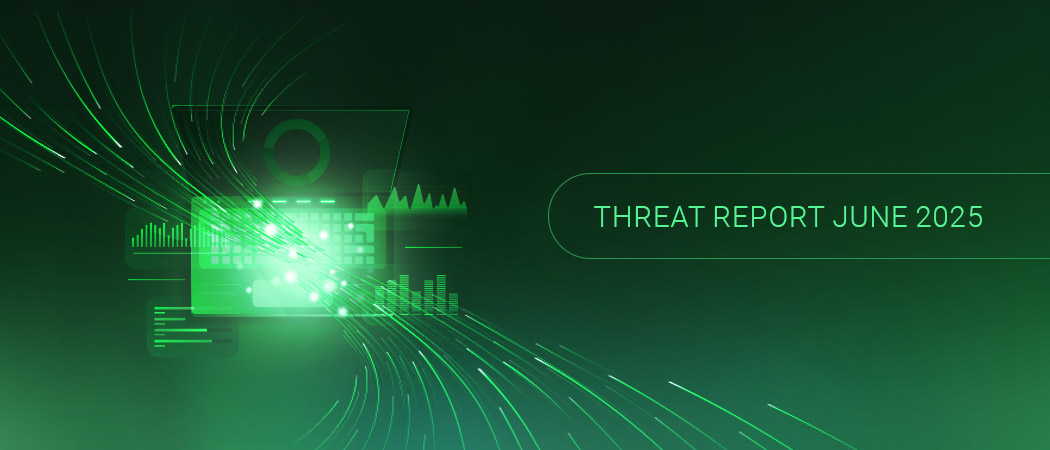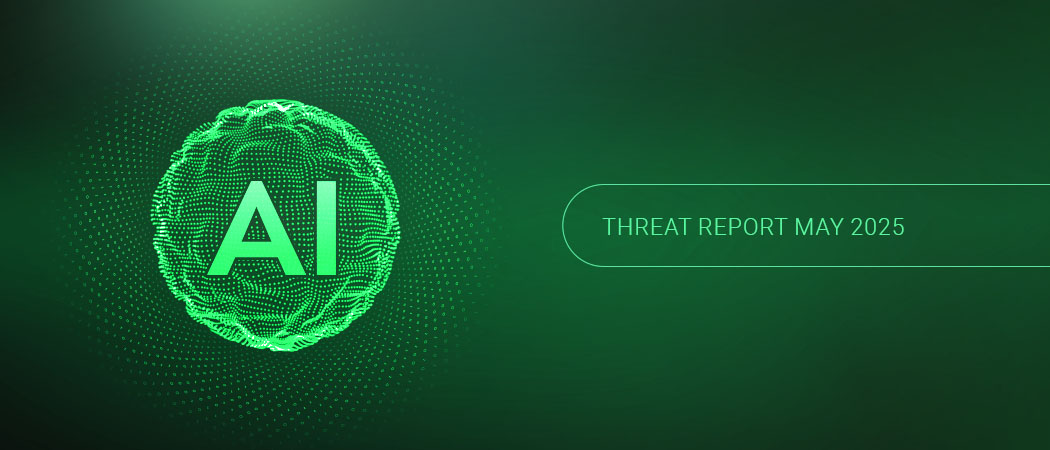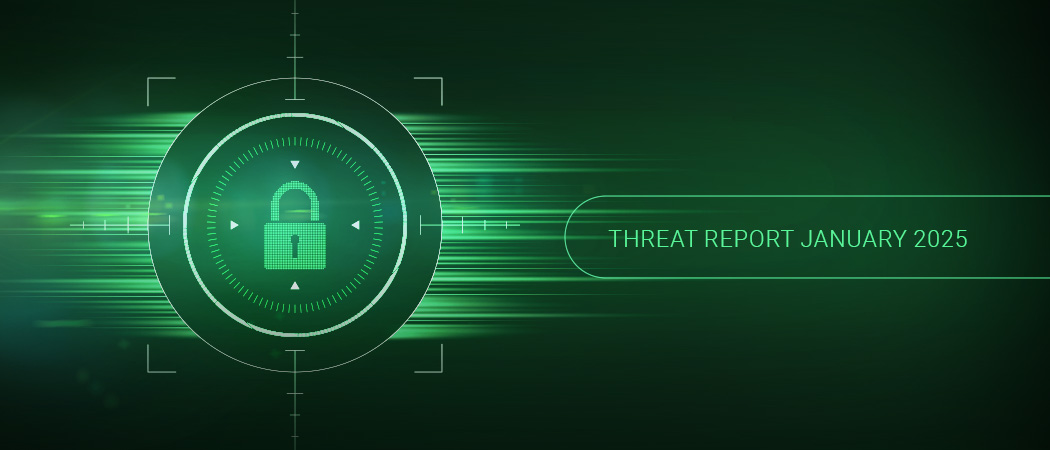The 2025 IOCTA report from Europol warns that demand for data on the cybercrime underground is surging. How much data has been stolen exactly? Determining exact numbers is impossible. However, the personal information of 190 million individuals including Social Security Numbers (SSN), was stolen from Change Healthcare in a single breach. That’s more than half of the total US population exposed in one incident. That incident pales in comparison to the 2024 National Public Data Breach, which included 272 million distinct SSNs, 420 million distinct addresses, and 161 million distinct phone numbers. In 2024, Europe saw approximately 363 breach notifications per day across surveyed EEA countries. Now, new strains of destructive wiper malware are emerging. In comparison, victims of data theft may soon be considered the “lucky” ones.

Cyber defenders are in a battle of attrition. Managing the continuous onslaught of new threats is a monumental and critical task. In this month’s threat report, we provide insight into the latest wave of wiper malware, new actively exploited vulnerabilities, and emerging threats shaping the global cyber conflict.
New Wave of Wipers Enter the Cyber Combat
Cisco Talos just observed a previously unknown wiper malware dubbed “PathWiper”, leveraged in a destructive attack against Ukrainian critical infrastructure. Wiper most often gets deployed during Cyber Warfare (CW) campaigns, when financial gain is not the primary motive. Whereas ransomware coerces victims into paying for the return of their encrypted data, wipers simply destroy it. Wipers have been used since the start of the Russia-Ukraine war. HermeticWiper was deployed against Ukraine in 2022, crippling government agencies and critical services hours before Russia first invaded.
Cybersecurity analysts also recently noted an emerging ransomware-as-a-service (RaaS) group, Anubis, which has added a wiper option to their custom ransomware payload. Amidst heightened geopolitical tensions, it’s plausible that nation-state threat actors will incentivize willing RaaS operators and hacktivists to carry out destructive attacks for impact.
Wiper attacks themselves aren’t new. Shamoon (aka Disttrack), discovered in 2012, was the first major Wiper malware. Suspected to be developed by Iranian threat actors, it was used to attack Saudi Aramco and other Gulf state organizations. Masquerading as ransomware, NotPetya was another prominent wiper strain that emerged in 2017 with global impact.
Organizations, especially critical infrastructure, need to consider the potential impact that wiper malware could have on their resilience. What if paying ransom is not an option? A well designed backup strategy can enable full or partial data recovery, but downtime also has a financial impact and has even recently resulted in loss of life. Ensuring that mean-time-to-recovery (MTTR) objectives can be realized is key to operational continuity. Of course, diligently closing security gaps before threat actors can exploit them is also essential to a proactive cyber strategy.
Sorting True Risk from “AI-Slop”: Linux CVEs in Flux
The days when Linux attracted fewer cyber attacks have long passed. Linux systems are increasingly targeted by sophisticated actors. Last year, the number of Linux kernel CVEs (Common Vulnerabilities and Exposures) also exploded: the Kernel CNA (CVE Numbering Authority) assigned an average of 55 new CVEs per week in 2024. This growth is sometimes attributed to AI uncovering bugs which are not actually security risks – dubbed “AI slop”. Curl’s creator, Daniel Stenberg, even posted a notice banning “AI slop” bug reports. A related bug report discussion raised the concern of “an attack on our resources to handle security issues”.
On the risk and patch management side of the coin, many defenders don’t have the luxury of conducting a deep investigation into each CVE’s technical feasibility. Conducting technical assessments and analyzing “patch diffs” takes enormous amounts of time. The resulting battle of attrition pits security teams against the clock. To prioritize remediation, they rely on CVSS (Common Vulnerability Scoring System), EPSS (Exploit Prediction Scoring System), exploit status, and environmental factors such as compliance requirements and operational criticality. Security leaders want to see evidence that progress is continuous and that security gaps are closed. This is truly the benefit of using a vulnerability management platform such as Greenbone.
That being said, here are some new high-risk Linux privilege escalation CVEs that gained attention this month:
- CVE-2023-0386 (CVSS 7.8): Now deemed actively exploited, the Linux kernel’s OverlayFS subsystem allows escalation to root-level by abusing how files with special privileges are copied between certain mounted filesystems.
- CVE-2025-6019 (CVSS 7.0): A flaw found in Fedora and SUSE distros allows non-root users in the “allow_active” group to execute privileged disk operations such as mounting, unlocking, and formatting devices via D-Bus calls to “udisksd”. The vulnerability is considered easy to exploit, and a public PoC (Proof of Concept) is available, increasing the risk.
- CVE-2025-32462 and CVE-2025-32463: Two local privilege escalation vulnerabilities were fixed in Sudo 1.9.17p1, released on June 30, 2025. CVE-2025-32462 allows local users to abuse the –host option to escalate privileges on permitted hosts, while CVE-2025-32463 permits unauthorized root access via the —chroot option, even when not explicitly allowed in the sudoers file.
- CVE-2025-40908 (CVSS 9.1): Unauthenticated attackers can modify existing files simply by processing a crafted YAML file as input, due to improper use of the two-argument open call. Vulnerable systems include any Perl applications or distributions (like Amazon Linux, SUSE, Red Hat, Debian) using YAML‑LibYAML before version 0.903.0.
CVE-2025-49113: A Critical Severity CVE in RoundCube Webmail
A recently disclosed vulnerability tracked as CVE-2025-49113 (CVSS 9.9) in RoundCube Webmail allows authenticated attackers to execute arbitrary code on a RoundCube server. A poorly designed PHP deserialization operation [CWE-502] fails to properly validate user input, allowing the “_from” parameter to carry malicious serialized code. Attackers who successfully exploit the bug can potentially gain full control over the RoundCube server to steal data and install command and control (C2) tools for persistent access.
Although CVE-2025-49113 requires valid credentials for exploitation, admin credentials are not required. Technical analysis [1][2], PoC exploits [3][4], and a Metasploit module are available, increasing the potential risk for abuse. An EPSS score of 81 indicates an extremely high probability of exploitation in the near future. Meanwhile, the researcher who discovered the flaw claims that exploit kits are already for sale on underground cybercrime forums. Numerous national CERT agencies have issued alerts for the flaw [5][6][7][8][9], while Shadowserver reported over 84,000 exposed Roundcube services existed in early June.
Greenbone Enterprise Feed includes remote version detection [10][11] and Linux Local Security Checks (LSC) [12][13][14][15][16][17] to identify vulnerable instances of RoundCube Webmail (versions prior to 1.5.10 and 1.6.11). Users are encouraged to apply updates with urgency.
New Critical CVE in Cisco ISE Cloud Has PoC Exploit
CVE-2025-20286 (CVSS 10) is a new flaw affecting Cisco Identity Services Engine (ISE) cloud deployments on AWS, Azure, and Oracle Cloud Infrastructure (OCI). The bug could allow unauthenticated, remote attackers to access sensitive data, perform some limited administrative operations, modify system configurations, and disrupt services. Due to poor software design, identical access credentials [CWE-259] are generated and shared across all connected ISE instances running the same release and platform.
Cisco has acknowledged the existence of a publicly available exploit. The vendor also stated that the vulnerability is only exploitable when the Primary Administration Node is deployed in the cloud. On-premises deployments and several hybrid/cloud VM solutions are not affected. Overall, the widespread use of Cisco ISE in enterprise networks and the availability of exploit code make CVE-2025-20286 a high-risk vulnerability for those with affected configurations. Greenbone includes a version detection test to identify instances that may be vulnerable.
CitrixBleed 2 and Another Actively Exploited Flaw in Citrix NetScaler ADC and Gateway
Dubbed “CitrixBleed 2”, CVE-2025-5777 (CVSS 9.3) is an out-of-bounds read [CWE-125] vulnerability affecting Citrix NetScaler ADC and NetScaler Gateway, which allows unauthenticated, remote attackers to steal valid session tokens from memory by sending malformed HTTP requests. CVE-2025-5777 is due to insufficient input validation – unfortunately, a common, yet easily preventable root cause of software bugs. Exposure of session tokens allows impersonation of legitimate users, resulting in unauthorized access. Security experts speculate that exploitation is imminent, drawing parallels to the original CitrixBleed (CVE-2023-4966) vulnerability leveraged by ransomware groups in high-profile breaches.
Another flaw, CVE-2025-6543 (CVSS 9.8), also affecting Citrix NetScaler ADC and Gateway, was added to CISA KEV, indicating that active exploitation is already underway. CVE-2025-6543 is a memory overflow vulnerability [CWE-119]. While the impact has been officially described as DoS, researchers believe it may come to arbitrary code execution or device takeover, as seen in similar past cases.
Both flaws only impact devices configured as Gateway (VPN virtual server, ICA Proxy, CVPN, RDP Proxy) or AAA (Authentication, Authorization, and Accounting) virtual servers. Both flaws are the subject of widespread national CERT advisories [1][2][3][4][5][6][7]. Greenbone provides a remote version check to detect CitrixBleed 2 and a remote version check for CVE-2025-6543. Users should patch with urgency.
A Trio of Exploitable Sitecore CMS Flaws
Three new CVEs affecting Sitecore Experience Platform can be chained to allow unauthenticated Remote Code Execution (RCE) . The flaws were disclosed with a full technical description and PoC guidance, making their exploitation highly likely. In the attack chain, CVE-2025-34509 provides initial authenticated access, while CVE-2025-34510 or CVE-2025-34511 are both post-auth RCE flaws. Attackers can first exploit hardcoded credentials to generate a valid session token, then upload a malicious “.aspx” web shell and proceed to execute arbitrary shell commands on the victim’s system. Alternatively, CVE-2025-34511 could be used to execute PowerShell commands instead of uploading a web shell.
Here are brief descriptions of each:
- CVE-2025-34509 (CVSS 8.2): Hardcoded credentials [CWE-798] allow remote attackers to authenticate using this account to access the admin API.
- CVE-2025-34510 (CVSS 8.8): A relative path traversal vulnerability [CWE-23] known as “Zip Slip” allows an authenticated attacker to extract malicious files from a ZIP archive into the webroot directory, which could lead to RCE via .aspx web shell.
- CVE-2025-34511 (CVSS 8.8): An unrestricted file upload vulnerability [CWE-434] in the PowerShell Extensions module allows an attacker to upload arbitrary files, including executable scripts, to any writable location. Although CVE-2025-34511 requires the Sitecore PowerShell Extension to be installed, this is considered a common configuration.
Sitecore is a popular enterprise Content Management System (CMS) used by major global organizations across industries. While it is estimated that Sitecore represents between 0.45% and 0.86% of the global CMS market share [1][2], this user base consists of high-value targets. Greenbone is able to detect vulnerable instances of Sitecore with an active check and a remote version detection test. Patches were released in Sitecore version 10.4 and backported to earlier supported versions, allowing users to upgrade.
Bypass of CVE-2025-23120 in Veeam Backups
CVE-2025-23121 (CVSS 9.9) is a deserialization flaw [CWE-502] that allows authenticated domain users to execute arbitrary code [CWE-94] on Veeam Backup & Replication servers. The vulnerability arises from insecure data processing and is considered a bypass of a previously patched flaw, CVE-2025-23120.
No public PoC exploit is currently available. However, CVEs in Veeam Backup & Replication are often targeted by attackers. Furthermore, the vulnerability only applies to organizations using domain-joined backup servers. However, it presents a serious threat given the importance of backups in ransomware recovery. Attackers may gain valid credentials for authentication via credential theft or use password spraying to target re-used credentials.
Greenbone can remotely detect affected Veeam products and prompt patching to version 12.3.2.3617, which is strongly recommended.
Summary
June 2025 saw the emergence of at least two new wiper malware strains, threatening to impact critical infrastructure and enterprises. Widespread massive data breaches are escalating, impacting organizations and individuals as stolen data gets used for various malicious ends. This month also saw a deluge of newly discovered, critical-severity vulnerabilities in enterprise-grade products, most of which were not covered in this report. Many with PoCs or full exploit kits available within hours of their disclosure. From RoundCube and Cisco ISE to Citrix and Linux systems, high-risk digital weaknesses that demand attention are escalating the cyber war of attrition for defenders worldwide.
It’s not “unauthenticated” because the first step is to gain authentication, right?





